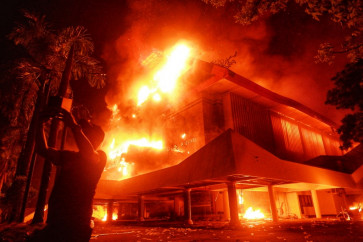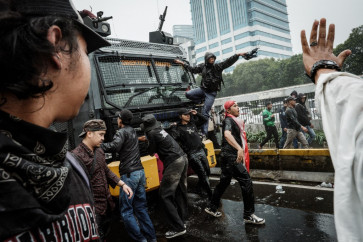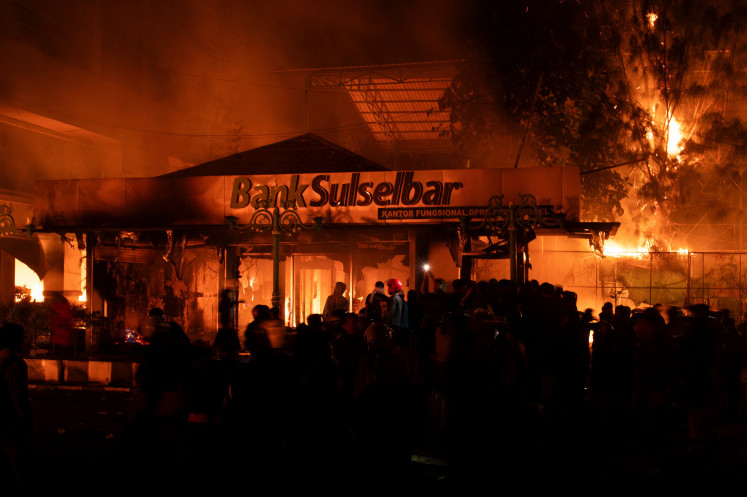Popular Reads
Top Results
Can't find what you're looking for?
View all search resultsPopular Reads
Top Results
Can't find what you're looking for?
View all search resultsFunding, screening access confines the aesthetics of documentary filmmakers
Negeri di Bawah Kabut (The Land Beneath the Fog) by Shalahuddin Siregar
Change text size
Gift Premium Articles
to Anyone
 Negeri di Bawah Kabut (The Land Beneath the Fog) by Shalahuddin Siregar. (Courtesy of Shalahuddin Siregar)" border="0" height="280" width="498">Negeri di Bawah Kabut (The Land Beneath the Fog) by Shalahuddin Siregar. (Courtesy of Shalahuddin Siregar)
Negeri di Bawah Kabut (The Land Beneath the Fog) by Shalahuddin Siregar. (Courtesy of Shalahuddin Siregar)" border="0" height="280" width="498">Negeri di Bawah Kabut (The Land Beneath the Fog) by Shalahuddin Siregar. (Courtesy of Shalahuddin Siregar)The availability of inexpensive video cameras, editing software and the Internet has led to an explosion in local documentary filmmaking.
While more Indonesians telling Indonesian stories from their own perspective is good, a vast number of local have been produced in cooperation with NGOs, focusing on their specific issues of interest â with mixed results for the local scene.
Local filmmaker BW Purbanegara cites his latest documentary, produced through cooperation with the United Nations Development Program (UNDP), as an example.
âI was hired to make a documentary about the bravery of local residents in dealing with disaster.â Of the Dancing Leaves, the filmâs title, chronicles life on the southern slope of Mount Merapi, the active volcano near Yogyakarta in Central Java.
Purbanegara, a philosophy graduate from Yogyakartaâs Gadjah Mada University, co-founded an independent production house based in Yogyakarta and saw his documentary Musafir (The Traveler) screen at the Berlinale in 2008.
Asked whether the issue that he explored in Of the Dancing Leaves, which was selected for exhibition in the Chopshots Documentary Film Festival, Purbanegara was direct.
 Di Balik Frekuensi (Behind the Frequency) by Ucu Agustin. (Courtesy of Ucu Agustin)
Di Balik Frekuensi (Behind the Frequency) by Ucu Agustin. (Courtesy of Ucu Agustin)
âIt is not a very interesting thing for me because I live with these people from day to day,â he said. âThis documentary was produced mostly because of the interest from NGOs. In this case, I am a filmmaker for hire. But I see a necessity to document what the public considers important.â
Purbanegara is not unique. Hundreds of other Indonesian documentary filmmakers, professional and amateur alike, have produced their projects within a framework of issues that are the pet causes of specific NGO, such as environmental conservation.
The Makassar-based documentary filmmaker Andi Arfan Sabran agreed with the influence of NGOâs on non-fiction filmmaking. âIn reality, it is one of the strategies to realize our visions of documentary.â
Sabran, whose documentary Paotere has travelled from Germany to South Korea to New Caledonia, said that that NGOs had different approaches to the creative process.
Some NGOs were strict in determining how a documentary should look like, some were not, he added. âIn many cases, it is the other way around. You are the one who tell them how a documentary should look like to touch the audiences.â
While the focus on such issue-oriented filmmaking has lead to a great variety in the themes that have been chosen, it has made local documentaries less than experimental in aesthetics and in approach.
âWe have a huge amount of thematic variety in Indonesian documentaries, but there has been almost no development in the matter of aesthetics for the last or three years,â said Fransiskus Apriwan, the director of Festival Film Dokumenter (Documentary Film Festival) of Yogyakarta.
Another essential aspect for filmmakers to consider is distribution and the exhibition â or how exactly to show their works to people. Unlike as in some western nations, âthere is no distribution scheme for documentaries in Indonesia,â said Apriwan.
This, of course, affects audiences: People exposed to conventional issue-oriented works are less likely to be receptive to documentaries that tell their stories in unconventional ways, such as Errol Morrisâ The Fog of War or Thin Blue Line.
 Negeri di Bawah Kabut (The Land Beneath the Fog) by Shalahuddin Siregar. (Courtesy of Shalahuddin Siregar)<)
Negeri di Bawah Kabut (The Land Beneath the Fog) by Shalahuddin Siregar. (Courtesy of Shalahuddin Siregar)<)
Negeri di Bawah Kabut (The Land Beneath the Fog) by Shalahuddin Siregar. (Courtesy of Shalahuddin Siregar)
The availability of inexpensive video cameras, editing software and the Internet has led to an explosion in local documentary filmmaking.
While more Indonesians telling Indonesian stories from their own perspective is good, a vast number of local have been produced in cooperation with NGOs, focusing on their specific issues of interest ' with mixed results for the local scene.
Local filmmaker BW Purbanegara cites his latest documentary, produced through cooperation with the United Nations Development Program (UNDP), as an example.
'I was hired to make a documentary about the bravery of local residents in dealing with disaster.' Of the Dancing Leaves, the film's title, chronicles life on the southern slope of Mount Merapi, the active volcano near Yogyakarta in Central Java.
Purbanegara, a philosophy graduate from Yogyakarta's Gadjah Mada University, co-founded an independent production house based in Yogyakarta and saw his documentary Musafir (The Traveler) screen at the Berlinale in 2008.
Asked whether the issue that he explored in Of the Dancing Leaves, which was selected for exhibition in the Chopshots Documentary Film Festival, Purbanegara was direct.
Di Balik Frekuensi (Behind the Frequency) by Ucu Agustin. (Courtesy of Ucu Agustin)
'It is not a very interesting thing for me because I live with these people from day to day,' he said. 'This documentary was produced mostly because of the interest from NGOs. In this case, I am a filmmaker for hire. But I see a necessity to document what the public considers important.'
Purbanegara is not unique. Hundreds of other Indonesian documentary filmmakers, professional and amateur alike, have produced their projects within a framework of issues that are the pet causes of specific NGO, such as environmental conservation.
The Makassar-based documentary filmmaker Andi Arfan Sabran agreed with the influence of NGO's on non-fiction filmmaking. 'In reality, it is one of the strategies to realize our visions of documentary.'
Sabran, whose documentary Paotere has travelled from Germany to South Korea to New Caledonia, said that that NGOs had different approaches to the creative process.
Some NGOs were strict in determining how a documentary should look like, some were not, he added. 'In many cases, it is the other way around. You are the one who tell them how a documentary should look like to touch the audiences.'
While the focus on such issue-oriented filmmaking has lead to a great variety in the themes that have been chosen, it has made local documentaries less than experimental in aesthetics and in approach.
'We have a huge amount of thematic variety in Indonesian documentaries, but there has been almost no development in the matter of aesthetics for the last or three years,' said Fransiskus Apriwan, the director of Festival Film Dokumenter (Documentary Film Festival) of Yogyakarta.
Another essential aspect for filmmakers to consider is distribution and the exhibition ' or how exactly to show their works to people. Unlike as in some western nations, 'there is no distribution scheme for documentaries in Indonesia,' said Apriwan.
This, of course, affects audiences: People exposed to conventional issue-oriented works are less likely to be receptive to documentaries that tell their stories in unconventional ways, such as Errol Morris' The Fog of War or Thin Blue Line.
Mangga Golek Matang di Pohon (The Mangoes). (Courtesy of Tonny Trimarsanto)
On the other hand, Purbanegara said that the many local documentaries produced in connection with NGOs were more likely to find an audience. 'NGOs have their own networks and partners, and our documentaries will be shown to these networks.'
Film festivals and television remain the two best outlets for filmmakers seeking to show their documentary work, according to Purbanugara.
'Aside from that, universities and local communities are also occasionally used.'
As an example, Apriwan tells a story about how a community in Kulonprogo, Yogyakarta, used a documentary to rally local residents in a campaign against the land occupation in their locale. 'Alternatively, documentaries are often made by a very political people for very political audiences.'
Asked on whether there was an independent distributor for documentary film in Indonesia, Apriwan shook his head.
'Another thing that we lack is the government's support,' Apriwan said. He cites a number of documentary writing competition held by the government in Yogyakarta. 'But that's it.'
In contrast to Apriwan, Purbanegara says that he has not been able to see any support given by the government so far.
'The only thing that government gives us is inspiration. Many excellent documentaries are made out of frustration felt towards a chaotic government.
He laughs. 'I should be thankful to them, in this sense.'









